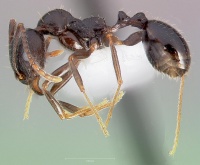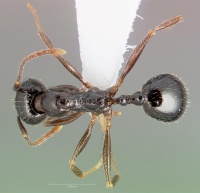Aphaenogaster patruelis
| Aphaenogaster patruelis | |
|---|---|

| |
| Scientific classification | |
| Kingdom: | Animalia |
| Phylum: | Arthropoda |
| Class: | Insecta |
| Order: | Hymenoptera |
| Family: | Formicidae |
| Subfamily: | Myrmicinae |
| Tribe: | Attini |
| Genus: | Aphaenogaster |
| Species: | A. patruelis |
| Binomial name | |
| Aphaenogaster patruelis Forel, 1886 | |
| Synonyms | |
| |
Identification
Aphaenogaster patruelis ranges in color from dark brown to black, with lighter legs. The spines are minute, less than the width of the propodeal spiracle. (DeMarco, 2015)
Keys including this Species
Distribution
Latitudinal Distribution Pattern
Latitudinal Range: 34.35874° to 23.23333333°.
| North Temperate |
North Subtropical |
Tropical | South Subtropical |
South Temperate |
- Source: AntMaps
Distribution based on Regional Taxon Lists
Nearctic Region: United States.
Neotropical Region: Mexico (type locality).
Distribution based on AntMaps
Distribution based on AntWeb specimens
Check data from AntWeb
Countries Occupied
| Number of countries occupied by this species based on AntWiki Regional Taxon Lists. In general, fewer countries occupied indicates a narrower range, while more countries indicates a more widespread species. |

|
Estimated Abundance
| Relative abundance based on number of AntMaps records per species (this species within the purple bar). Fewer records (to the left) indicates a less abundant/encountered species while more records (to the right) indicates more abundant/encountered species. |

|
Biology
Castes
Nomenclature
The following information is derived from Barry Bolton's Online Catalogue of the Ants of the World.
- patruelis. Aphaenogaster patruelis Forel, 1886b: xli (w.) MEXICO (Guadeloupe).
- Type-material: lectotype worker (by designation of Mackay & Mackay, 2017: 346), 1 paralectotype worker.
- Type-locality: lectotype Mexico: Guadeloupe I., 200 mi. off Baja California (H.C. McCook); paralectotype with same data.
- Type-depository: MHNG.
- Wheeler, W.M. 1934f: 133 (m.); Mackay & Mackay, 2017: 348 (q.).
- Combination in Stenamma (Aphaenogaster): Emery, 1895c: 302;
- combination in Aphaenogaster (Attomyrma): Emery, 1921f: 59.
- Subspecies of subterranea: Emery, 1895c: 302.
- Status as species: Dalla Torre, 1893: 103; Forel, 1899c: 58; Wheeler, W.M. 1904d: 270; Wheeler, W.M. 1910g: 565; Wheeler, W.M. 1917a: 516; Emery, 1921f: 59; Wheeler, W.M. 1934f: 132; Wheeler, W.M. 1935g: 17; Creighton, 1950a: 146; Smith, M.R. 1958c: 117; Smith, D.R. 1979: 1362; Bolton, 1995b: 71; Ward, 2005: 31; Mackay & Mackay, 2017: 346 (redescription).
- Senior synonym of bakeri: Smith, D.R. 1979: 1362; Bolton, 1995b: 71; Mackay & Mackay, 2017: 346.
- Senior synonym of willowsi: Creighton, 1950a: 146; Smith, M.R. 1958c: 117; Smith, D.R. 1979: 1360; Bolton, 1995b: 71; Mackay & Mackay, 2017: 346.
- Distribution: Mexico, U.S.A.
- bakeri. Stenamma (Aphaenogaster) patruele subsp. bakeri Wheeler, W.M. 1904d: 270 (w.) U.S.A. (California: Catalina).
- Type-material: syntype workers (number not stated, “from two colonies”).
- Type-locality: U.S.A.: California, Catalina I., 1904 (C.F. Baker).
- Type-depositories: AMNH, LACM, MCZC.
- Combination in Aphaenogaster: Wheeler, W.M. 1916h: 143;
- combination in Aphaenogaster (Attomyrma): Emery, 1921f: 59.
- Subspecies of patruelis: Wheeler, W.M. 1910g: 565; Wheeler, W.M. 1917a: 516; Emery, 1921f: 59; Wheeler, W.M. 1935g: 17; Creighton, 1950a: 147; Smith, M.R. 1951a: 797; Smith, M.R. 1958c: 117.
- Junior synonym of patruelis: Smith, D.R. 1979: 1362; Bolton, 1995b: 68; Mackay & Mackay, 2017: 346.
- willowsi. Aphaenogaster patruelis subsp. willowsi Wheeler, W.M. 1933a: 64 (w.) U.S.A. (California: Santa Barbara Is).
- Type-material: holotype worker.
- Type-locality: U.S.A.: California, Santa Barbara Is, San Nicolas I., 15.iii.1932 (no collector’s name; probably M. Willows).
- Type-depository: CASC.
- Subspecies of patruelis: Wheeler, W.M. 1935g: 17; Smith, M.R. 1951a: 797.
- Junior synonym of patruelis: Creighton, 1950a: 146; Smith, M.R. 1958c: 117; Smith, D.R. 1979: 1360; Bolton, 1995b: 74; Mackay & Mackay, 2017: 346.
Unless otherwise noted the text for the remainder of this section is reported from the publication that includes the original description.
Description
Worker
Wheeler (1933) for Aphaenogaster patruelis willowsi - Differing from the typical patruelis in having the base of the epinotum straight and horizontal, not convex, and in certain details of coloration. Head, pronotum, pedicel and gaster very smooth and shining, base of epinotum very finely and indistinctly transversely striate, especially on the sides; mandibles, clypeus, cheeks and meso- and mctapleurae sharply, longitudinally rugulose. The epinotal teeth, though very small and resembling those of the much paler subspecies bakeri Wheeler from Catalina Island, are more slender and fully twice as long as broad at their bases. Deep reddish castaneous, almost black; mandibles, gula, the 4-jointed clubs of the antennre, scapes, trochanters, tips of coxae and legs red, the femora and tibiae dark brown, except at their bases and tips.
Male
Wheeler (1934) - measures about 3.5 mm. Head through the eyes slightly wider than long, broadly rounded behind, with very short cheeks. Mandibles well-developed, 6-toothed. Antennal scapes nearly four times as long as broad; funiculi long, the four terminal joints elongate, each constricted at its base and, with the exception of the terminal joint, also a1:.i its apex. Thorax long, through the wing-insertions broader than the head; mesonotum large, subhexagonal, as broad as long, anteriorly very convex and projecting, depressed posteriorly just in front of the scutellum; epinotum small, low and narrow, in profile with long, medially somewhat concave base and short, abrupt declivity, the two surfaces meeting at a right-angle. Petiole and postpetiole much as in the worker, but the nodes lower and more rounded. Gaster like that of the worker; legs more slender; hind tibiae slightly bent near the base. Sculpture and color as in the worker, but the body darker, nearly black; pilosity even less developed. Wings slightly brownish; veins brown; pterostigma dark brown.
Type Material
Wheeler (1933) - Aphaenogaster patruelis willowsi A single specimen from San Nicolas Island (III.15.' 32). Type, C. A. S. Ent., No. 3684.
References
- Alatorre-Bracamontes, C.E., Vásquez-Bolaños, M. 2010. Lista comentada de las hormigas (Hymenoptera: Formicidae) del norte de México. Dugesiana 17(1): 9-36.
- Creighton, W. S. 1950a. The ants of North America. Bulletin of the Museum of Comparative Zoology 104: 1-585 (page 146, Senior synonym of willowsi)
- DeMarco, B.B. 2015. Phylogeny of North American Aphaenogaster species (Hymenoptera: Formicidae) reconstructed with morphological and DNA data. Ph.D. thesis, Michigan State University.
- Emery, C. 1895d. Beiträge zur Kenntniss der nordamerikanischen Ameisenfauna. (Schluss). Zool. Jahrb. Abt. Syst. Geogr. Biol. Tiere 8: 257-360 (page 302, Combination in Stenamma (Aphaenogaster); Subspecies of subterranea)
- Emery, C. 1921c. Hymenoptera. Fam. Formicidae. Subfam. Myrmicinae. [part]. Genera Insectorum 174A:1-94 94: 1-94 + 7 (page 59, Combination in Aphaenogaster (Attomyrma))
- Forel, A. 1886b. Espèces nouvelles de fourmis américaines. Ann. Soc. Entomol. Belg. 30:xxxviii-xlix. (page xli, worker described)
- Smith, D. R. 1979. Superfamily Formicoidea. Pp. 1323-1467 in: Krombein, K. V., Hurd, P. D., Smith, D. R., Burks, B. D. (eds.) Catalog of Hymenoptera in America north of Mexico. Volume 2. Apocrita (Aculeata). Washington, D.C.: Smithsonian Institution Pr (page 1362, Senior synonym of bakeri)
- Wheeler, W. M. 1904e. Ants from Catalina Island, California. Bull. Am. Mus. Nat. Hist. 20: 269-271 (page 270, Revived status as species)
- Wheeler, W. M. 1933a. The Templeton Crocker Expedition of the California Academy of Sciences, 1932. No. 6. Formicidae of the Templeton Crocker Expedition. Proc. Calif. Acad. Sci. (4) 21: 57-64.
- Wheeler, W. M. 1934f. Ants from the islands off the west coast of Lower California and Mexico. Pan-Pac. Entomol. 10: 132-144 (page 133, male described)
References based on Global Ant Biodiversity Informatics
- Backlin, Adam R., Sara L. Compton, Zsolt B. Kahancza and Robert N. Fisher. 2005. Baseline Biodiversity Survey for Santa Catalina Island. Catalina Island Conservancy. 1-45.
- Dattilo W. et al. 2019. MEXICO ANTS: incidence and abundance along the Nearctic-Neotropical interface. Ecology https://doi.org/10.1002/ecy.2944
- DeMarco B. B., and A. I. Cognato. 2016. A multiple-gene phylogeny reveals polyphyly among eastern North American Aphaenogaster species (Hymenoptera: Formicidae). Zoologica Scripta DOI: 10.1111/zsc.12168
- Emery C. 1895. Beiträge zur Kenntniss der nordamerikanischen Ameisenfauna. (Schluss). Zoologische Jahrbücher. Abteilung für Systematik, Geographie und Biologie der Tiere 8: 257-360.
- Johnson, R.A. and P.S. Ward. 2002. Biogeography and endemism of ants (Hymenoptera: Formicidae) in Baja California, Mexico: a first overview. Journal of Biogeography 29:10091026/
- Longino, J.T. 2010. Personal Communication. Longino Collection Database
- Mallis A. 1941. A list of the ants of California with notes on their habits and distribution. Bulletin of the Southern California Academy of Sciences 40: 61-100.
- Vasquez-Bolanos M. 2011. Checklist of the ants (Hymenoptera: Formicidae) from Mexico. Dugesiana 18(1): 95-133.
- Wheeler W. M. 1916. An anomalous blind worker ant. Psyche (Cambridge) 23: 143-145.
- Wheeler W. M. 1917. The mountain ants of western North America. Proceedings of the American Academy of Arts and Sciences 52: 457-569.
- Wheeler W.M. 1935. Check list of the ants of Oceania. Occasional Papers of the Bernice Pauahi Bishop Museum 11(11):1-56.
- Wheeler, William Morton. 1904. Ants From Catalina Island, California. Bulletin of the American Museum of Natural History. XX. 269-271.
- Wheeler, William Morton. 1904. Ants from Catalina Island, California in Bulletin of the American Museum of Natural History. 20:269-271.
- Wheeler, William Morton. 1933. Formicidae of the Templeton Crocker Expedition. California Academy of Sciences. 21(6):57-64.
- Wheeler, William Morton. 1934. Ants From The Islands Off The West Coast Of Lower California and Mexico. The Pan-Pacific Entomologist. 10(3):131-144.

